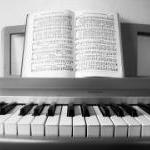
Peter Quantick
Members-
Posts
21 -
Joined
-
Last visited
About Peter Quantick

Profile Information
-
Biography
Born in Dawlish, Devon in 1953 into a music loving family. I learned piano, cello and music theory and was active in church choirs, the school choir and orchestra. My Grammar School encouraged music and I performed in Noyes Fludde as cellist (Britten), Trial by Jury as Tenor (Gilbert and Sullivan) and St Nicholas (Britten). I also did some composing which I have always enjoyed. This included composing a piece for our house orchestra in our School Eisteddfod.
After I left school for University, I became consumed by another life and although I enjoyed listening to music, and did some composing, my music took back stage to family and work.More recently, though I have been involved in local choirs as a singer and accompanist. I have used my retirement and the COVID lockdown to put onto paper the many compositions I sketched over 50 years ago. I’ve used them as a basis for music I have composed for family and friends mainly.
I really just want to get my music “out there” to see and hear what it sounds like in a concert hall or studio. For me, at the end of my life (rather than the beginning !) getting my music committed to paper so that maybe someone, somewhere, will enjoy it is my main motivation. -
Gender
Male
-
Location
UK, Wales
-
Occupation
Retired
-
Interests
Music, singing in a choir, reading, keeping fit, my family!
-
Favorite Composers
Bach, Beethoven, Poulenc, Stravinsky, Tchaikowsky, Caroline Shaw, Messiaen
-
My Compositional Styles
Neoclassical, pandiatonic
-
Notation Software/Sequencers
Sibelius
-
Instruments Played
Piano, cello
Recent Profile Visitors
329 profile views
Peter Quantick's Achievements
-
Hi there. Thanks for the comments. I agree about the balance in the lengths of the two movements. Overall I wanted a stark contrast between the styles of the two movements with the Intro being more tonal and minimalist and the Allegro more aggressive and modernist. I'll have a look at editing down the intro, I think and probably make the Allegro end less suddenly with a coda maybe based on the middle section of the Allegro. Thanks again. It's great to get feedback.
-
I enjoyed your Psalm 150 and I like this too. In particular, the use of key change is nice, especially the ending in A major. I especially liked the staccato parts around bars 48 - 52. That made an interesting contrast. The quaver dotted crotchet rhythm at the start and the gradual introduction and overlapping of voices is nice and you do introduce this motif at the end but maybe you could have used it a bit more across, maybe from bars 90 onwards? Thanks for sharing. I wondered if these two Psalms could be two movements or sections in a longer work with the ones you've shared being movements 2 and 3 and perhaps Ps 122 as a middle tempo piece as movement 1? Best wishes Peter
-
Next movement of band piece by Evan!
Peter Quantick replied to Eickso's topic in Orchestral and Large Ensemble
This is just great. I love the energy and the textures you create. It's certainly ambitious but it really pays off. The ostinato, the time signature changes, the use of percussion all combine to great effect. It looks as though earlier versions made you revisit and rework the piece and that's all part of being creative, I reckon. Thanks for sharing this. It's a really enjoyable piece. -
Hi there. It's a lovely little tune with a baroque sound as JoshL37 has noted. I also think that you have a good basis to build on. Maybe you could use it as a starting point for a set of variations on a theme? What you have here would be a theme worth exploring with a neoclassical edge, maybe? Thanks for sharing.
-
Hi there. It's good isn't it. I like unaccompanied choral music as it puts me in mind of my time as a chorister many years ago. I think my knowledge of counterpoint and harmony was shaped by that. I like the use of counterpoint in your work and also the tension created by the changing time signatures. Not much to say about your piece really. I liked it a lot. It's pretty high for the sops in particular ( but nowhere near the top E in Poulenc's "La Figure Humaine" - love that piece). I'll have another listen to see if anything more comes to me. But thanks for sharing. I enjoyed it. I've got a choral work which is like yours and a MP3 file which I might share here so thanks for the inspiration.
-
I can't find the link either...??? Please repost. This sounds interesting.
-
Hi there. Thanks for sharing this. It's a really nice piece. I agree with the member above that the ostinato sections are really good and the harmonic changes bit could be made more exciting and more consistent with the opening of the piece by continuing the use of the running scales and arpeggios, maybe? Rather like the right hand part around 1.01 mins? I like the single note ostinato transition into the Allegro section and the transition out of it but maybe you could revisit the themes/cells used at the beginning of the piece at the end to expand it a bit so maybe its like an aria (A B A) in form? Really look forward to hearing more of your work.
-
Love your feedback on this new video of my work
Peter Quantick replied to Jaando's topic in Chamber Music
I like this piece. As the previous member has said it has a simplicity about it which is really endearing and engaging. It reminded me of Spiegel im Spiegel by Arvo Part in its development. Its really nicely executed as well. Thanks for sharing it. Good luck with the Youtube channel. -
At the County Fair - Arcade
Peter Quantick replied to MJFOBOE's topic in Orchestral and Large Ensemble
I like it. Your description of it is quite accurate of an arcade at a fair at night. It is quite wild and atmospheric. Its quite "filmic" - is that a word and the sound track approach is maybe a route you should explore further if you're thinking of revisiting the longer composition. Thanks for sharing. -
I like it. It's a nice exercise in counterpoint. I'm no expert on the rules relating to this as it's something I learnt years ago. What I really loved were the syncopated bits around bar 18 et seq. You could use that more, it was really nice. It put me in mind of "Bach Goes to Town" by Alec Templeton and maybe "Handel in the Strand" by Percy Grainger. Do you know them? They're really great. Hope this helps. You've only been composing for a relatively time but keep at it. I'd like to hear more.
-
Folk Song Suite for small ensemble
Peter Quantick replied to Peter Quantick's topic in Chamber Music
I have a similar piece based on Cornish Folk Songs that I composed for some friends which I'll post here if you'd like to see it? -
Thanks. Here they are as Musescore link and MP3 file. The Musescore playback doesn't sound great. I'd be grateful for your feedback! Come Sorrow Come v5.mp3
-
Folk Song Suite for small ensemble
Peter Quantick replied to Peter Quantick's topic in Chamber Music
Thanks. My inspirations are wide ranging. Muse went to the same High School I did ( some time before!!!) -
It's a very nice piece and shows off the romantic qualities of the guitar. I've been trying to write for guitar and am not a guitarist and have found it challenging. Can I share it here for you to review and comment on how playable it is, please?


.thumb.png.8b5b433a341551e913a34392660bc95b.png)



